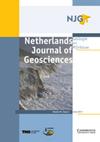在荷兰古景观重建中使用地质、地貌和土壤制图产品
IF 2.3
2区 地球科学
Q3 GEOSCIENCES, MULTIDISCIPLINARY
Netherlands Journal of Geosciences-Geologie En Mijnbouw
Pub Date : 2020-07-15
DOI:10.1017/njg.2020.8
引用次数: 5
摘要
地质、地貌图和土壤图提供了关于基底以及过去和现在的自然景观的重要信息。对于荷兰沿海平原和莱茵-默兹三角洲的深入研究,许多这样的地图数据集在过去的两个世纪里已经编制完成。这些制图材料包括较老和较年轻的遗留数据集,通常在区域上分散。它们是由地质学家、土壤科学家、地貌学家和景观考古学家等各方根据不同的研究传统编制的。这些地图和数据集总结了过去几个世纪积累的大量基础数据,因此对重建过去的景观很有价值。在过去的几十年里,数字基础设施的发展增加了重新组合现有数据和新数据的可能性,例如通过地理信息系统解决方案,如古地理基础图,可以从中生成多个衍生地图产品。需要综合各种源图和基础数据的专题信息,以充分利用累积的数据多样性,并回答应用和基本的科学问题。然而,使用不同的信息来编制或更新地图,需要了解遗留的测量策略以及制作原始数据和地图时的知识状况。本文回顾了土壤、地质和地貌制图的传统。我们评估了他们的产品,基础数据和他们的汇编背后的原因,重点是他们在传统和数字古地理制图中的应用。这有助于充分利用大量的传统和现代数据,这是大数据时代表面和基材数字测绘的主要挑战。本文章由计算机程序翻译,如有差异,请以英文原文为准。
The use of geological, geomorphological and soil mapping products in palaeolandscape reconstructions for the Netherlands
Abstract Geological, geomorphological and soil maps provide important information on the substrate as well as on the past and present physical landscape. For the intensely studied Netherlands coastal plain and Rhine–Meuse delta, many such map datasets have been compiled over the last two centuries. These mapping materials comprise older and younger legacy datasets, often fragmented over regions. They have been compiled within various research traditions and by various parties, involving geologists, soil scientists, geomorphologists and landscape archaeologists. The maps and datasets summarise overwhelming amounts of underlying data accumulated over the last few centuries, and are therefore valuable for reconstructing past landscapes. Digital-infrastructure developments have enhanced possibilities for recombining existing and new data over the last few decades, e.g. through GIS solutions such as palaeogeographical base maps, from which multiple derived map products can be generated. Integration of thematic information from various source maps and underlying data is needed to use the accumulated data diversity to its full potential and to answer applied and fundamental scientific questions. Using diverse information to compile or update maps, however, requires awareness of legacy surveying strategies and the state of knowledge at the time the original data and maps were produced. This paper reviews the soil, geological and geomorphological mapping traditions. We evaluate their products, underlying data and the reasoning behind their compilation, focusing on their use in conventional and digital palaeogeographical mapping. This helps get the most out of large quantities of legacy and modern data, a major challenge for surface and substrate digital mapping in the big-data era.
求助全文
通过发布文献求助,成功后即可免费获取论文全文。
去求助
来源期刊
CiteScore
4.00
自引率
25.90%
发文量
14
审稿时长
>12 weeks
期刊介绍:
Netherlands Journal of Geosciences - Geologie en Mijnbouw is a fully open access journal which publishes papers on all aspects of geoscience, providing they are of international interest and quality. As the official publication of the ''Netherlands Journal of Geosciences'' Foundation the journal publishes new and significant research in geosciences with a regional focus on the Netherlands, the North Sea region and relevant adjacent areas. A wide range of topics within the geosciences are covered in the journal, including "geology, physical geography, geophyics, (geo-)archeology, paleontology, hydro(geo)logy, hydrocarbon exploration, modelling and visualisation."
The journal is a continuation of Geologie and Mijnbouw (published by the Royal Geological and Mining Society of the Netherlands, KNGMG) and Mededelingen Nederlands Instituut voor Toegepaste Geowetenschappen (published by TNO Geological Survey of the Netherlands). The journal is published in full colour.

 求助内容:
求助内容: 应助结果提醒方式:
应助结果提醒方式:


